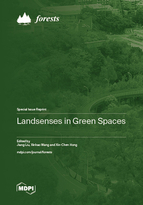Landsenses in Green Spaces
A special issue of Forests (ISSN 1999-4907). This special issue belongs to the section "Urban Forestry".
Deadline for manuscript submissions: closed (31 December 2023) | Viewed by 20467
Special Issue Editors
Interests: multi-sensory landscape experience and mechanism; soundscape design and soundscape resource management; landsenses ecology; ecological planning and design
Special Issues, Collections and Topics in MDPI journals
Interests: environmental planning; resilience; geographic information system
Interests: noise; social sensing; urban planning; computational social science; public health; urban forests
Special Issues, Collections and Topics in MDPI journals
Special Issue Information
Dear Colleagues,
We are inviting submissions for the Special Issue focusing on “Landsenses in Green Spaces”.
The term “landsenses” comes from “landsenses ecology”. As a newly emerging scientific discipline based on ecological principles and the analytical framework of natural elements, physical senses, psychological perceptions, socio-economic perspectives, process-risk, and associated aspects, it integrates landscape ecology with people’s vision and social needs, focusing on land-use planning, construction, and management toward sustainable development. Landsenses emphasize the integration of human perception from sensory and psychological dimensions into ecological environmental research. Green spaces, as important ecological infrastructure, provide multiple ecological system services and contribute to human well-being—especially in densely built environments. Theories and technical approaches are becoming increasingly multi-disciplinary concerning how landscape experience can affect human mental and/or physical status and well-being. The fields concerned with the planning, design and management of green spaces also highlight the role of multi-sensory perception led by traditional visual perception in landscape experience, with an aim of creating high-quality landscape. In this context, we believe that the theory proposed by landscape ecology could not only be an effective way to explore the relationship between human and the environment, but also an important methodological and technical approach for green space development.
Thus, we propose this Special Issue, “Landsenses in Green Spaces”. We welcome submissions of original research articles, reports or technical notes, reviews, and mini-reviews covering, but not limited to, the following topics:
- Mechanisms of multi-sensory interaction and the effects;
- Indicators for landsenses characteristics of green spaces;
- Landsenses with cultural and regional significance;
- Theoretical and technical approaches for landsenses creation;
- Innovative application of Internet of Things and multi-source data in green space studies;
- Social perception, machinery perception and virtual reality;
- Planning, design and management of green space based on landsenses ecology.
Prof. Dr. Jiang Liu
Prof. Dr. Xinhao Wang
Dr. Xin-Chen Hong
Guest Editors
Manuscript Submission Information
Manuscripts should be submitted online at www.mdpi.com by registering and logging in to this website. Once you are registered, click here to go to the submission form. Manuscripts can be submitted until the deadline. All submissions that pass pre-check are peer-reviewed. Accepted papers will be published continuously in the journal (as soon as accepted) and will be listed together on the special issue website. Research articles, review articles as well as short communications are invited. For planned papers, a title and short abstract (about 100 words) can be sent to the Editorial Office for announcement on this website.
Submitted manuscripts should not have been published previously, nor be under consideration for publication elsewhere (except conference proceedings papers). All manuscripts are thoroughly refereed through a single-blind peer-review process. A guide for authors and other relevant information for submission of manuscripts is available on the Instructions for Authors page. Forests is an international peer-reviewed open access monthly journal published by MDPI.
Please visit the Instructions for Authors page before submitting a manuscript. The Article Processing Charge (APC) for publication in this open access journal is 2600 CHF (Swiss Francs). Submitted papers should be well formatted and use good English. Authors may use MDPI's English editing service prior to publication or during author revisions.
Keywords
- green space
- landsenses ecology
- multi-sensory interaction
- psychological perception
- environmental behavior and health
- Internet of Things
- sustainable development








